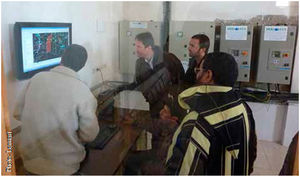Knowledge fuels change
For over a decade, Energypedia has shared free, reliable energy expertise with the world.
We’re now facing a serious funding gap.
Help keep this platform alive — your donation, big or small, truly matters!
Thank you for your support
SPIS Toolbox - Credit Policy: Select/develop Suitable Financial Instruments

Introduction
Do want to know all about SPIS – Solar Powered Irrigation System : Please go to the newly launched standalone Solar Powered Irrigation Systems (SPIS) website (www.spis-toolbox.org) , featuring three SPIS toolbox:
- Toolbox for beginners,
- Toolbox for farmers (new SPIS Web based App – to calculate design of the pumps),
- the Toolbox for experts - the updated version - Version 6
and additional resources (Publication about SPIS).
The Toolbox on Solar Powered Irrigation Systems (SPIS) is designed to enable advisors, service providers and practitioners in the field of solar irrigation to provide broad hands-on guidance to end-users, policy-makers and financiers. Risks related to system efficiency, financial viability and the unsustainable use of water resources can thus be minimized. The Toolbox comprises informative modules supplemented with user-friendly software tools (calculations sheets, checklists, guidelines). read more
Modules and tools touch upon:
- assessing the water requirements,
- comparing the financial viability,
- determining farm profitability and payback of investment in SPIS,
- sustainably design and maintain a SPIS,
- highlight critical workmanship quality aspects,
- and many more.

style="width: 160px; background-color: rgb(111, 142, 43);" | ►Back to the Module Page
Credit Policy: Select/develop Suitable Financial Instruments
When selecting or developing a loan product for SPIS it is important to ask the following questions:
- Who? Market oriented producers, no subsistence production, producer groups possible;
- What? Finance for energy source and pumping system used for irrigation; energy and/or water saving technology;
- How much? Establish range of loan sum; % own-contribution of producer; % subsidy;
- when? Range of loan period (years); repayment frequency (months); disbursement in tranches;
- Interest rate? From..x..% p.a. to ..x..% p.a. (range);
- Collateral? Equipment, mortgages, additional collateral (guarantee scheme), non-traditional collateral (future harvest, warehouse), leasing scheme with equipment providers.
Loan products for financing SPIS usually:
- have higher initial investment sums with consequently longer repayment periods and/or high installment rates;
- need alternative guarantee schemes/ unconventional collateral;
- have higher interest rate payments due to higher credit risk and long investment period;
- focus on innovative clients, usually investing in high(er) value crops;
- should be strictly oriented towards water capacity available and the farm’s specific requirements;
- use no blueprint; every farm/enterprise is unique!
In order to prevent prohibitive loan transaction costs, consider:
- guarantee funds with public support or insurance;
- leasing schemes with pumping system providers and others;
- group financing approaches for producer groups;
- public subsidies and sponsoring;
- favorable refinancing options for the financial institution (e.g. subsidized interest rates offered by donors/public entities).
In order to overcome the information gap in respect of the new technology, introduce additional activities such as:
- encouraging (potential) clients to get informed and consult technical advice;
- training and sensitization of loan staff on basics about the technology;
- monitoring loan performance closely;
- continuous dialogue with solar power sector.
Note: SPIS clients could become future clients for other financial products (cross selling).
Outcome/Product
- Guidelines and Procedures: including assessment and decision guidelines, target key performance indicators (KPIs).
Data Requirements
- Comparable clients liquidity pattern in current agricultural portfolio.
Compute, prepare
- repayment plan (with varying interest rates, repayment periods and repayment frequencies);
- profitability margins by crops and farm sizes;
- tables for evaluating types of collateral;
- list of eligible crops;
- list of eligible irrigation systems and average investment cost per component;
- list of eligible SPIS configurations and average investment cost per component (see DESIGN and GET INFORMED;
- list of eligible types of collateral.
People/Stakeholders
- Management level of financial service providers;
- Experienced credit staff (senior, agrifinance);
- Associations of producers / potential borrowers;
- Agricultural extension services;
- Research and training institutes (e.g. environmental agency);
- Providers of service, technology and inputs.
Important Issues
- Prevent prohibitive transaction costs for borrowers;
- Overcome information gap of financial operator;
- Note that standardization potential is limited.
- Select excellent loan staff for this segment with corresponding background and experience (train them!).




















